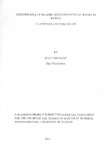| dc.description.abstract | Islamic banking is the system of banking consistent with principles of Islamic law (shariah) and
guided by Islamic economics. Islamic economics is referred to that body of knowledge which
helps realize human well-being through an allocation and distribution of scarce resources that is
in conformity with Islamic teaching without unduly curbing individual freedom or creating
continued macroeconomics and ecological imbalances. Islamic banking is grounded in the
Islamic principles and all undertakings of the banks follow Islamic morals. Two basic principles
behind Islamic banking are the sharing of profit and loss and, significantly, the prohibition of
usury, the collection and payment of interest, also commonly called Riba. Like conventional
bank, an Islamic bank is an intermediary and trustee of money of other people but the difference
is that it shares profit and loss with its depositors. This difference that introduces the element of
mutuality in Islamic banking makes its depositor a customer with some ownership rights in it,
Dar and Presley (2000).
The aim of this study was to examine and compare performance of Islamic banks, the Gulf
African Bank and First Community Bank, and five conventional banks in Kenya. Both the
Islamic and conventional banks sampled are within fourth tier of bank ranking per Central Bank
of Kenya and all have asset base of less than ten billion shillings. The analysis involved
extraction of financial ratios from the banks’ published accounts and comparing the means for
each category against the industry averages. Four broad categories of financial performance
measures were considered and for each category two financial ratios were calculated and
compared. The four broad categories of performance measures considered are profitability,
liquidity, efficiency and risk and solvency of banks.
The result of the study indicates that on the whole the conventional banks performed better than
the Islamic banks during the period under review. The study found Islamic banks to be more
liquid than the conventional banks. This however may not necessarily be an indication of better
performance because more liquidity leads to less return and therefore affects other aspects of
performance.
Conventional banks on the other hand performed better in profitability, and efficiency. On risk
and solvency, the Islamic banks seemed to perform better but while the trend for conventional
banks was showing to be stable, the Islamic banks were showing increasing risks. And therefore
considering that the Islamic banks have only been in Kenya for a short period, the fast increase in
risk is an indicator they may be more risky than the conventional banks. | en |

